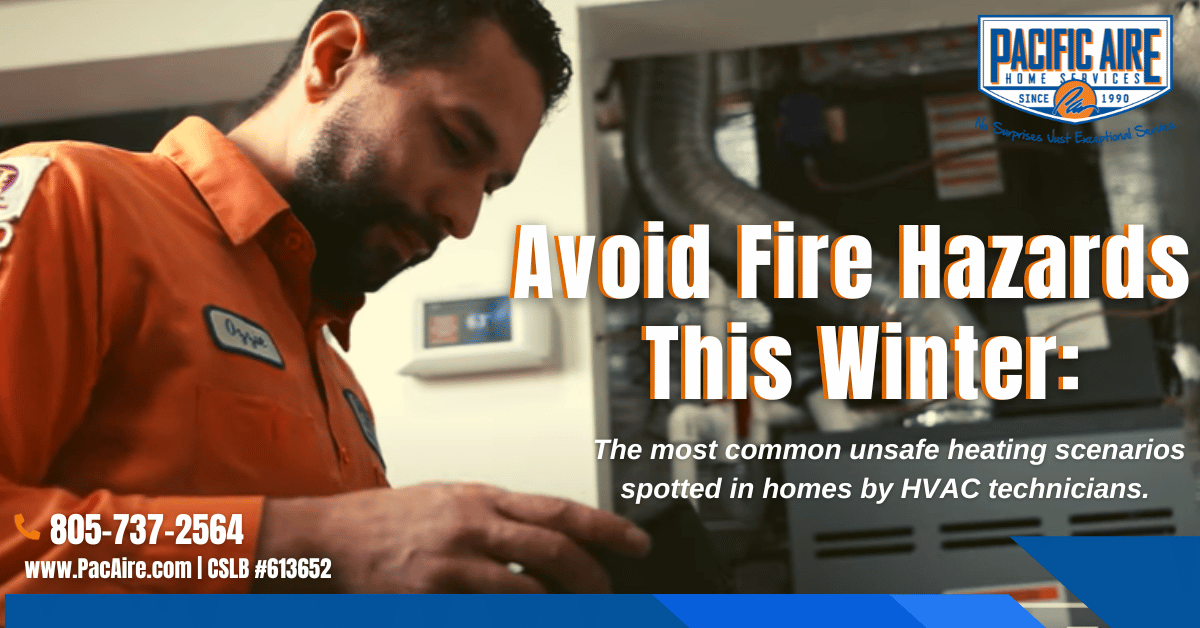Our goal is to help you protect your family from fires caused by heating or electrical systems as they are two of the leading causes of house fires.
We are always available to our customers during emergencies and we also encourage our customers to take a proactive approach to their home’s safety. Most of us don’t think about electricity very often, despite the fact that we use it almost every day. It is important for homeowners to keep in mind some things about their electrical systems.
It only takes a slight malfunction to cause serious loss and damage. The following are the most common unsafe heating scenarios spotted by HVAC technicians in homes and some tips on avoiding fire hazards in the winter:
➜ Damaged cords
Long-term use can damage the protective barrier insulating the electrical wires in power cords. Electric shock or electrocution is more likely to occur if these cords are touched. Make sure to replace the damaged cords if you spot them at home.
➜ Overloaded outlets
Electrical fires can occur as a result of overloading outlets. An overloaded outlet will usually trip a breaker. As a fire safety measure, a breaker cuts off the connection when a high current level is detected. However if the breaker malfunctions and fails to trip it can lead to big problems. If you notice dimming lights, buzzing outlets, or burning smells, you may have too many things plugged in. Make sure the outlets are not overloaded.
➜ Long-term use of extension cords
Extension cords are not designed for long-term permanent use, so they eventually deteriorate. Electric shock or fire hazards are increased as a result. Make sure to replace your extension cords if the protective coating is damaged or cracked.
➜ Water and electricity together
Since water conducts electricity, the combination can be dangerous. Always keep appliances away from water and dry your hands before using them. GFCIs should be installed in any room with running water (bathrooms, kitchens, laundry rooms). An electrical fire extinguisher should also be in every home.
➜ CO detectors not being tested
Carbon monoxide detectors must be tested for safety. CO is odorless and colorless and can build to dangerous levels from malfunctioning appliances, inadequate indoor ventilation, fumes from the garage entering the house, and barbecuing too close to an open window. Detectors have a test button that makes a sound if the battery is working. Health and safety tests may be required monthly depending on the manufacturer.
➜ Not testing smoke detectors
Smoke detectors have the same test button as CO detectors. Change the battery if it doesn’t sound. The detector should be replaced if it still doesn’t work. A smoke alarm has an average lifespan of ten years, slightly longer than a CO detector.
➜ Lack of routine professional check-ups
Identify problems before they become emergencies. An electrical inspection should include checking main breaker panels, GFCIs, and smoke and carbon monoxide detectors, among others, for safety and efficiency.
➜ Doing furnace repairs yourself
Leave furnace repairs to the professionals. Let professionals repair your furnace if it needs to be repaired. Attempting to fix your own furnace can cause much bigger problems for your family, including high levels of carbon monoxide, fire hazards, future repairs, and high energy bills.
➜ Failing to maintain your furnace
Regular furnace maintenance is the first step in preventing furnace-caused problems such as home fires. Your furnace’s cracks and leaks can allow gas to escape, creating a fire hazard. An annual tune-up includes an inspection of your burner assembly and heat exchanger, as well as other critical components. Your furnace will run more efficiently and safely if it is maintained throughout the winter.
➜ There’s no proper ventilation
Your home releases dangerous fumes, like carbon monoxide, through a flue in the roof. Keeping this vent clear prevents those gases from backing up into your home and posing a health risk. Regularly inspect your furnace vents for leaves and animals such as birds.
➜ A cluttered area
It is possible for your furnace to become quite hot if it is cluttered. Any combustible materials should be kept away from the three-foot radius around your furnace. It is dangerous to place things too close to a heat source. According to the NFPA, this is the leading cause of home fire deaths, accounting for 53% of the deaths in 2010. Make sure there are no flammable materials near your furnace. You should also have a professional take a look at the walls around the heater if they are warm or discolored.
Visit https://bit.ly/pacificaire-heating-tune-up or call us at 805-737-2564 to make sure your home’s furnace or heating equipment is safe and hazard-free this winter. Schedule a tune-up with the Pacific Aire experts.


